I do my first flight with a TSA Waiver.
On Saturday evening, I did my first photo flight that required a TSA waiver.
As most pilots should know, there is a temporary flight restriction (TFR) over certain sporting events. I can’t remember the specifics, but college football games definitely fall into the category.
I’d been contacted by a photographer from Minnesota who needed to take some aerial photos of the December 1 football game at Sun Devils Stadium in Tempe, home of ASU. The flight required a waiver from the TSA to enter the airspace.
Getting the Waiver
Getting the waiver isn’t difficult, but it does require some effort and a lot of patience. Start by going to the TSA/FAA Waiver and Authorization page on the TSA Web site. You’ll register as a user and log in. You’ll then have to provide information about the event and why you want a waiver. Be prepared to enter information about the pilot and all passengers, including pilot certificate numbers and social security numbers. Click the button to submit the information.
You’ll see a page telling you that you need to fax TSA an authorization letter. This is a letter from the folks that manage the venue that says they know you’re coming and have given you permission to operate. TSA will not grant a waiver without this so don’t skip this step.
Now wait while the TSA does all their background checks.
A few days — and I do mean few — before the event, you’ll get a fax or e-mail with the waiver document. It includes an authorization number and a bunch of other info about the waiver.
You’re Not Done Yet
If you’re a trusting soul, you might believe you’re all done and clear to enter the airspace. Not so fast! As my client warned me, local air traffic control sometimes has no idea that you got a waiver.
On the day of the event, start by calling the Flight Service Station at 800-WX-BRIEF. Talk to a briefer. Tell him your name and N-Number and let him know about your operation. Give him any info he wants. He might not want any, but it’s important to get this call on record.
Next, call the tower for the controlling airspace. In my situation, Sun Devils Stadium is within the Phoenix Class Bravo airspace, so I called Phoenix tower. Well, I didn’t at first — the phone number doesn’t seem to be listed anywhere. So I called Sky Harbor Airport and talked to someone in “Air Side Operations.” He called the tower and called me back with a fax and phone number. I faxed the waiver (twice, by accident; don’t ask), then followed up with a phone call. I told the controller what I was planning: several flights in the vicinity of the stadium before and during the game.
“You know the stadium is on the approach path for runways 25, right?” the controller said.
“Yes,” I replied (see image below).
“If you’re too close, we might have to ask you to move to the south when a plane is coming in.”
I assured her that I was prepared to do anything they needed me to do.

As shown here in this GoogleMaps image, Sun Devils Stadium is on the approach to the south side of Sky Harbor International Airport.
Finally, remember to bring a copy of the waiver with you, just in case someone asks to see it. You’re required to have it with you during the flight.
Dodging Jets
My Saturday flight was delayed until the absolute last minute. The weather all day was rainy and windy, with low clouds and bad flying conditions. My client had flown in from Minnesota that morning. He called several times throughout the day. Finally, at 4 PM, he gave me the green light. He wanted me at Sky Harbor in time for sunset.
By that time, the weather in Wickenburg was much improved, with blue skies to the west and overhead. Mike and I headed out at top speed, racing with the sun. We landed at Cutter. Mike got out and took the front passenger door off and went into the FBO with it. He returned moments later with my client. To save time, I didn’t even shut down.
After a quick safety briefing — the guy has probably been in more types of helicopters than I have — we took off to the stadium. I reminded the tower that I had a waiver. I was told to proceed east, remaining south of the runways and to let them know when I was ready to turn north and get on station.
The sun had just set behind a partly cloudy western horizon when we were ready to get into position. It was 5:30. The game was scheduled to start at 6 PM. The stadium was half-full and both teams were warming up on the field.
That’s when the fun began. I was literally right in the path of landing aircraft, including some heavy metal. Since I was just below the altitude of approaching aircraft, wake turbulence was a real issue. Every few minutes, the tower and I would have an exchange like this:
“Helicopter Zero-Mike-Lima, traffic three miles to the east is an Airbus heavy landing at the south complex.”
I’d look and see landing lights coming right at me. “Zero-Mike-Lima has the traffic in sight.”
“Helicopter Zero-Mike-Lima, retain visual separation from the traffic. Caution wake turbulence.”
“Zero-Mike-Lima.”
Depending on where we were, and how close the plane was, I’d react. Either I’d continue on a slow pass along the east side of the stadium, 600-800 feet up or I’d break off the pass, dropping altitude to gain speed and move to the south. After moving out of the way, I’d maneuver slowly out there until the landing plane was abeam the stadium, then zip back in for another pass.
When I say this happened about 20 times during 2 separate 20-minute flights, I’m not exaggerating. I was the fly dodging the big metal fly swatters. At night.
(In all honesty, it’s a lot easier to see other traffic at night because of their landing lights. It’s just not always easy to judge distances.)
My client was extremely understanding and patient. He was familiar with the danger of wake turbulence. I’d been warned about it by my first flight instructor and that was as much as I wanted to know about it. I never wanted to experience it firsthand. So I was careful and we didn’t get into any.
At one point, the tower asked how much longer we’d be. My client held up a hand with five fingers. “Five minutes,” I reported. I soon realized why he was asking. The planes started coming continuously, giving us few chances for additional passes.
Finally, after one good slow pass, my client announced he was done.
The tower was just telling a Boeing 737 on final where we were. When he told us about the Boeing, I was already on my way back. I asked permission to land and was cleared, told to stay south of the runway. The Boeing passed us on the ground just as I started my descent over the FedEx ramp.
My client left me and Mike returned with the door. We flew back to Wickenburg in the darkness, not seeing stars in the clear night sky until we were well past the bright lights of Phoenix.



 This photo is the last one I snapped on the flight. I was flying east on Tropicana at 3000 feet MSL. Then the Alt (short for alternator) light on my panel illuminated and didn’t go out. That meant there was a pretty good chance I had an alternator failure. And if there’s one thing any pilot will tell you, it’s not a good idea to start a 2-hour flight across empty desert without an alternator.
This photo is the last one I snapped on the flight. I was flying east on Tropicana at 3000 feet MSL. Then the Alt (short for alternator) light on my panel illuminated and didn’t go out. That meant there was a pretty good chance I had an alternator failure. And if there’s one thing any pilot will tell you, it’s not a good idea to start a 2-hour flight across empty desert without an alternator.
 I don’t remember too much about the flight. I know that the first 40 to 50 minutes was spent flying first across some half-neglected farmland and then over relatively flat open and deserted desert. One highlight was seeing a pretty large herd of sheep being tended by a single dog; when he heard me coming, he rounded all the sheep up into a frantic group. After that, I got my camera ready for other photo ops. But the only interesting things I passed were the remains of old hogans or corrals.
I don’t remember too much about the flight. I know that the first 40 to 50 minutes was spent flying first across some half-neglected farmland and then over relatively flat open and deserted desert. One highlight was seeing a pretty large herd of sheep being tended by a single dog; when he heard me coming, he rounded all the sheep up into a frantic group. After that, I got my camera ready for other photo ops. But the only interesting things I passed were the remains of old hogans or corrals. Yes, I was still on the Rez. The Navajo reservation, as I’ve said earlier in this narrative, is huge. I was flying from near its most northeastern point (Farmington) to near its most southwestern point (near Flagstaff). It would take me about an hour and a half just to make that flight.
Yes, I was still on the Rez. The Navajo reservation, as I’ve said earlier in this narrative, is huge. I was flying from near its most northeastern point (Farmington) to near its most southwestern point (near Flagstaff). It would take me about an hour and a half just to make that flight. I rounded the southern end of the Chuska Mountains and adjusted my course slightly to the west to overfly Window Rock. I started to climb. The terrain below me was rising with tall pines all around. The few homes I flew over looked more like winter residences than year-round homes.
I rounded the southern end of the Chuska Mountains and adjusted my course slightly to the west to overfly Window Rock. I started to climb. The terrain below me was rising with tall pines all around. The few homes I flew over looked more like winter residences than year-round homes.
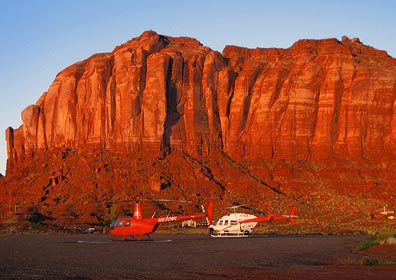 Outside, as dawn broke, a young Navajo man stepped out of the car that had been parked next to the Long Ranger on the helipad beside mine. Turned out, he’d been hired as security for the helicopter and had spent the night in his car.
Outside, as dawn broke, a young Navajo man stepped out of the car that had been parked next to the Long Ranger on the helipad beside mine. Turned out, he’d been hired as security for the helicopter and had spent the night in his car.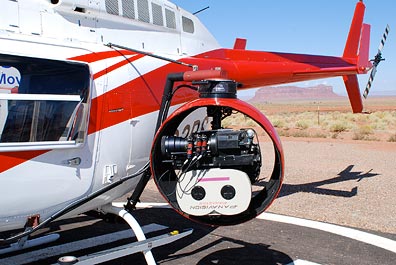 The camera guys were out with their truck again, working on the mount they’d put on the Long Ranger. Now they had a big ball on one side that turned out to be the camera mount and camera. The pilot and his fuel guy came by for a quick chat with them before they all took off for a meeting at the nearby high school, where the rest of the film crew were gathered.
The camera guys were out with their truck again, working on the mount they’d put on the Long Ranger. Now they had a big ball on one side that turned out to be the camera mount and camera. The pilot and his fuel guy came by for a quick chat with them before they all took off for a meeting at the nearby high school, where the rest of the film crew were gathered.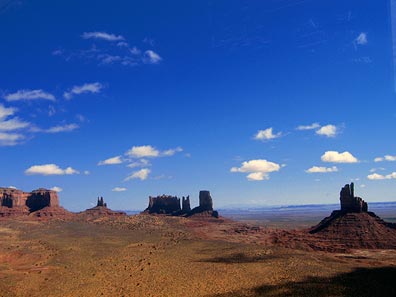 I flew through the northwest corner of Monument Valley, snapping a few photos along the way. These weren’t the great artistic photos my passengers had snapped during our flights. They were quick point-and-shoot images taken left-handed through the plexiglas. A way to document my trip and share images with blog readers. (I still hope to get a few low-res images from the photographers to share here.)
I flew through the northwest corner of Monument Valley, snapping a few photos along the way. These weren’t the great artistic photos my passengers had snapped during our flights. They were quick point-and-shoot images taken left-handed through the plexiglas. A way to document my trip and share images with blog readers. (I still hope to get a few low-res images from the photographers to share here.)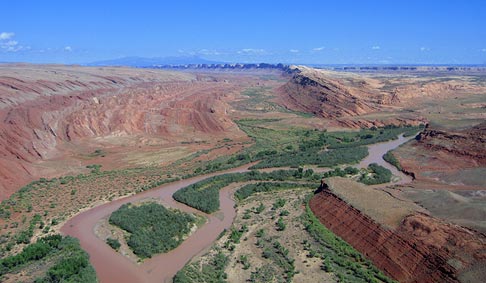
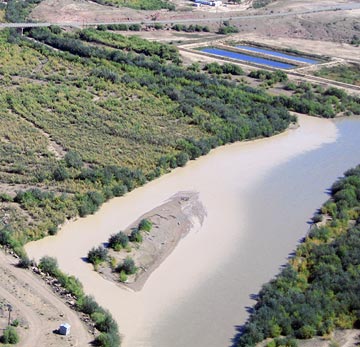 The canyons leveled out and I continued following the river through relatively flat terrain. The river, which was a greenish tan color, was being fed in many places by side streams of silty runoff water from the previous day’s rain. It was interesting to see the places where the two water flows met.
The canyons leveled out and I continued following the river through relatively flat terrain. The river, which was a greenish tan color, was being fed in many places by side streams of silty runoff water from the previous day’s rain. It was interesting to see the places where the two water flows met. My GPS clearly showed the intersection of four state lines. I was approaching
My GPS clearly showed the intersection of four state lines. I was approaching 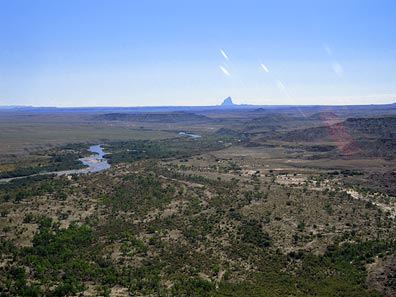
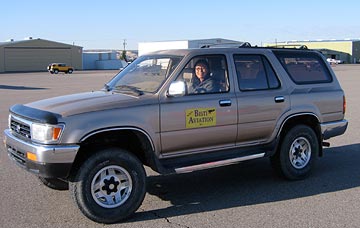 I do need to say a bit more about this courtesy car. It was the absolute worst car I’d ever driven in my life. It was a Toyota SUV with manual transmission. I have no trouble driving a stick shift car — all three of my vehicles have manual transmission. But the clutch pedal on this one would stick to the floor. You’d put it in first gear and start moving, then go to push the clutch down to shift into second, but the pedal was already on the floor and the clutch was not engaged. I quickly learned to use the toe of my shoe to pull the pedal back up after each shift. I kept things simple by sticking to first and second gear and parking in the very first spot I found in town. On the way back, I had a bit of trouble and thought I’d actually finished off the transmission. But then I got it moving again and returned it to the FBO. It was an interesting experience — very funny but frustrating at the same time.
I do need to say a bit more about this courtesy car. It was the absolute worst car I’d ever driven in my life. It was a Toyota SUV with manual transmission. I have no trouble driving a stick shift car — all three of my vehicles have manual transmission. But the clutch pedal on this one would stick to the floor. You’d put it in first gear and start moving, then go to push the clutch down to shift into second, but the pedal was already on the floor and the clutch was not engaged. I quickly learned to use the toe of my shoe to pull the pedal back up after each shift. I kept things simple by sticking to first and second gear and parking in the very first spot I found in town. On the way back, I had a bit of trouble and thought I’d actually finished off the transmission. But then I got it moving again and returned it to the FBO. It was an interesting experience — very funny but frustrating at the same time.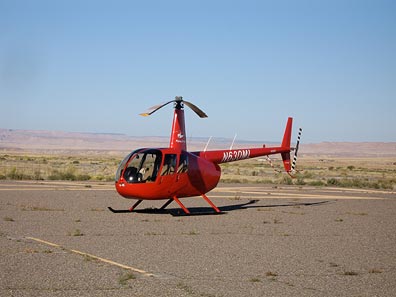 Four SUVs and a crowd of Russians waited for me at Shiprock’s lonely little airstrip. The wind was howling from the southeast. I set down on the ramp, cooled down the engine, and shut down. As I joined my future passengers, I wondered what the local police would think if they drove up and found a helicopter and four SUV loads of Russians on temporary visas.
Four SUVs and a crowd of Russians waited for me at Shiprock’s lonely little airstrip. The wind was howling from the southeast. I set down on the ramp, cooled down the engine, and shut down. As I joined my future passengers, I wondered what the local police would think if they drove up and found a helicopter and four SUV loads of Russians on temporary visas.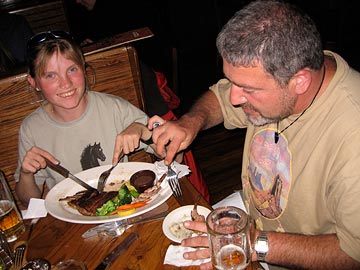 We put the doors on, stowed my luggage in their SUV, and took off in search of the Super 8 where we were staying. That’s when we discovered that Farmington was a lot bigger than we’d all thought. The motel was on the far east side of town, right next door to a Wal-Mart. Before checking in, though, we hit an Outback Steak House for a quick meal. It was after 9 PM and I kept things light.
We put the doors on, stowed my luggage in their SUV, and took off in search of the Super 8 where we were staying. That’s when we discovered that Farmington was a lot bigger than we’d all thought. The motel was on the far east side of town, right next door to a Wal-Mart. Before checking in, though, we hit an Outback Steak House for a quick meal. It was after 9 PM and I kept things light.